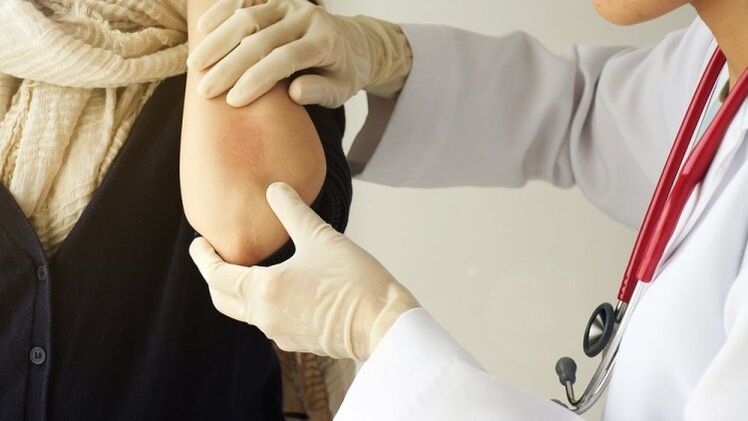Psoriasis is one of the most common chronic skin diseases. Through this pathological process, the damage to the skin and skin appendages was noticed. The urgency of this problem is that it will lead to a decline in the quality of life of patients due to aesthetic obstacles.
In most cases, the first episode of psoriasis occurs between 15 and 45 years of age. According to statistics, about 3% of the population suffers from this disease. In addition, the proportion of women and men suffering from this disease is equal.
There are several theories about the mechanism of psoriasis development. The main one is autoimmune theory, which says that this pathological process is formed due to a false immune response to any external factors. Excessive immune response can cause inflammation in the skin layer, which triggers the division and proliferation of cell structures. In addition, it is hypothesized that genetic susceptibility and exposure to various sources of infection may play a role in the development of this disease.
It is worth noting that psoriasis most commonly occurs in the following people:
- Have any other skin diseases;
- Thin and dry skin;
- Smoking and drinking
- Systematic exposure to irritating chemicals;
- They usually damage the skin due to mechanical influences;
- Pay attention to excessive hygiene;
- Under severe pressure;
- Reduce the level of immune defense or use drugs that suppress immunity.
According to the symptoms of psoriasis, it is customary to divide this pathology into several forms:
- Plaque shape. This form is the classic version. It happens to more than 80% of people. The clinical manifestations of this case are characterized by typical scaly plaques, which tend to grow on the periphery;
- Teardrop shape. Diseases that proceed in this form are accompanied by many small lesions on the surface of the skin. Such lesions may have very different colors, bulge and peel off strongly above the skin surface. Usually, their size will not increase, only increase;
- Exudation form. This is one of the most unfavorable options. In this case, air bubbles and blisters filled with slurry will form on the surface of the plaque. In many cases, these elements will be infected secondary, and then pus will appear;
- Psoriatic nail dystrophy. It is characterized by the nail plate participating in the pathological process, becoming streaked and thickened. In most cases, nails will discolor, peel and break. In advanced cases, complete loss of the nail plate is possible;
- Psoriasis arthropathy. In this case, the symptoms of psoriasis manifest as inflammation of the joints and connective tissues. In some cases, this form will develop on its own, but the most common is accompanied by skin manifestations;
- Psoriasis erythroderma. This form is characterized by a very serious course and usually fatal. Note the development of inflammation in a large area of the body, accompanied by intense peeling and detachment of the skin.
The main symptoms of psoriasis

We will discuss the classic form in more detail. What does psoriasis look like? First, on the surface of the skin, a single pink or red papule will appear. These papules are covered with silvery white scales, which can be easily scraped off. Over time, the number of pimples increased and they began to fuse into plaques.
The plaques that form during this disease have the appearance of hyperemia and edema. In some cases, mild itching of the skin may occur. Pathological lesions have a rapid peripheral growth trend, and their surface is strongly flaky. Over time, the growth of the plaques stops and their boundaries become clear. A specific sign of this pathological process is the margin of pseudo-atrophy, located on the periphery of the lesion. In the stationary phase, a stagnant cyan tone appears on the surface of the patch.
The symptoms of degenerative psoriasis are characterized by desquamation gradually disappearing from the middle. After that, the skin acquires a normal color, after which the tissue infiltration disappears.
Diagnosis and treatment of this disease

First, psoriasis is determined based on its clinical manifestations. There are three specific phenomena that indicate this pathological process: stearic spots, end membranes, and blood show. The phenomenon of stearic spots is that when the lesion is scratched, the peeling becomes more intense. If we continue to scrape, we will notice the film peeling and the appearance of wet and hyperemic surfaces-the end-membrane phenomenon. The phenomenon of blood show suggests that there is spotting bleeding and further scratching.
Among the drugs used to treat this disease, the following drugs can be used:
- Glucocorticoids;
- Cytostatic
- Antihistamines;
- Cuticle separation and anti-inflammatory ointment.
In addition, various physical therapies are also widely used.
Prevent the worsening of psoriasis
To prevent the condition from getting worse, it is recommended to avoid stressful situations, get rid of bad habits and eat well. In addition, you should limit any irritation to the skin and avoid contact with substances to which you are allergic.























